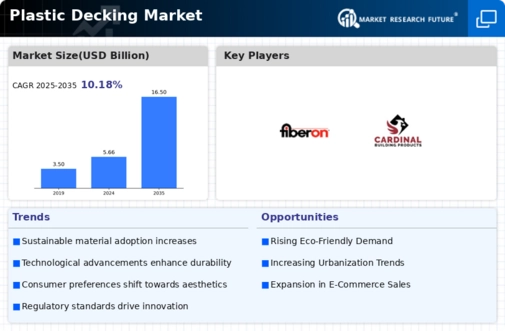Market Trends
Key Emerging Trends in the Plastic Decking Market
The plastic decking market is undergoing significant trends that reflect the shifting preferences in the construction and outdoor living industries. Plastic decking, often made from composite materials or PVC (polyvinyl chloride), offers a durable, low-maintenance alternative to traditional wood decking. One notable trend is the increasing demand for sustainable and eco-friendly decking materials. As environmental consciousness grows, consumers and builders are turning to plastic decking options that utilize recycled materials and boast a longer lifespan than traditional wood, reducing the environmental impact associated with decking materials.
The product variation in the plastic decking market is the crucial driver for the market. The plastic decking is available in PVC, PP, LDPE, and HDPE. This plastic decking comes with exceptional resistance and durability. The product variation is a crucial driver for the plastic decking market. Also, there are capped and uncapped plastic composites that are highly useful in the construction industry. The capped plastic decking is used as a UV coating.
Moreover, the market is experiencing a surge in the use of plastic decking in residential and commercial construction projects. Plastic decking's resistance to rot, decay, and insect damage, coupled with its ease of maintenance and longevity, makes it an attractive choice for decking applications. The versatility of plastic decking in terms of color, texture, and design options allows homeowners and builders to achieve the desired aesthetic without compromising on performance. This trend aligns with the increasing demand for durable and visually appealing outdoor spaces.
Additionally, there is a focus on technological advancements in plastic decking to enhance performance and aesthetics. Innovations such as capped composites, which feature an additional protective layer to resist fading, staining, and scratching, contribute to the longevity and aesthetics of plastic decking. The integration of advanced manufacturing processes, including co-extrusion and embossing techniques, allows for the production of decking materials that mimic the natural appearance of wood while retaining the benefits of plastic. This trend reflects the industry's commitment to providing high-performance and visually appealing decking solutions.
Furthermore, the market is influenced by the growing interest in deck customization and personalization. Plastic decking manufacturers are offering a range of color options, surface textures, and finishes, allowing consumers to tailor their outdoor spaces to match individual preferences and architectural styles. This trend aligns with the desire for unique and personalized outdoor living environments, driving the adoption of plastic decking as a versatile and customizable decking solution.
The plastic decking market is also witnessing increased attention to slip resistance and safety features. Manufacturers are incorporating technologies and surface treatments that enhance the slip resistance of plastic decking, addressing concerns related to safety, especially in wet conditions. This trend aligns with the industry's focus on providing decking solutions that prioritize the well-being of users, contributing to the appeal of plastic decking in various applications.
Despite these positive trends, challenges exist within the plastic decking market. The perception of plastic materials in comparison to traditional wood can be a consideration for some consumers, and education about the benefits of plastic decking is crucial. Additionally, variations in pricing among different plastic decking options and the initial investment cost may impact decision-making for budget-conscious consumers.


 Source: Secondary Research, Primary Research, Market Research Future Database and Analyst Review
Source: Secondary Research, Primary Research, Market Research Future Database and Analyst Review


Leave a Comment